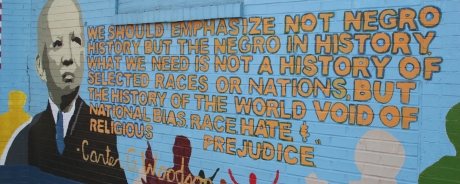Carter G. Woodson House National Historic Site
Part of National Capital Parks - East
Washington, D.C.
Visited: November 11, 2006
NPS Site Visited: 329 OF 353
NPS Website

WHAT IS IT?
1915-1950 Shaw neighborhood home of Carter G. Woodson: professor, pioneering historian and founder of Black History Month.
BEAUTY (1/10)
The Woodson House is an abandoned row house in a not so picturesque part of NW Washington, D.C. A trompe l'oeil mural opposite the Site paints a curtained windowsill and a vase of flowers onto another abandoned building. Underneath the faux window reads, “Bienvenue à Shaw. Slum historique.”
Painted a little further down the same wall is a much less disconcerting and far more inspiring mural dedicated to Mr. Woodson. In it, his proud likeness sits next to an idealistic quote proclaiming that history should not be subdivided into selective race-based studies but should emphasize everybody's role without prejudice, bias and hate.
HISTORIC SIGNIFICANCE (7/10)
Carter G. Woodson's achievements, vision and historical influence are monumental. Woodson was born to former slaves in 1875 Virginia during the height of Reconstruction and just ten years after the Civil War's end. Over the course of his life he would, the Park brochure states, “almost single-handedly establish African American historiography.”
Before Woodson, little to no written history concerning the nearly 400 years of African American contributions existed. In much of the South, black literacy was punishable by death. Woodson created not just a field of study or a month of remembrance; he asserted and inserted the lives and accomplishments of a displaced people into their rightful place in American history. He made it imperative for us to listen to the voices that weren't allowed to speak.
When Woodson died in 1950, there were no African American studies departments, graduate or undergraduate majors at any university. Academia only taught the classics, western history and the thoughts and accomplishments of those in power. What would Woodson think to know that now all the Ivy League schools, the apex of the American ivory tower, have African American studies program and that Woodson's history doctorate alma mater, Harvard, now offers an African American Studies doctorate degree?
His Shaw neighborhood mural indicates that he might not agree with this genre-ized direction. Was Woodson's goal to integrate African American history and the history of the muted voices into the general American history canon? Has that happened and can it happen as long as Gender, Gay, Lesbian, Native American, Asian American, Latino, Bisexual, etc... Studies programs exist?
Hard to say. But these are just a few of the many questions that could be addressed when the Carter G. Woodson Home NHS opens. Which, by the look of things, won't be for at least ten years. We do know that through Woodson's inclusion into the National Park System he and his dream has officially become a part of the canon. And not a moment too soon.
CROWDS (1/10)
There were a lot of homeless people milling about the abandoned lots that border the row house. We weren't that scared until a man who appeared to have a mental illness began repeatedly screaming “get out of here” in an urgent, territorial and garbled voice. He didn't stop until we were three blocks away.
 EASE OF USE/ACCESS (1/5) EASE OF USE/ACCESS (1/5)
The Home is located at the corner of 9th and Q Streets NW near their intersection with Rhode Island Avenue. There are currently no Park facilities, just an inaccessible building awaiting renovation. Lots of renovation. You can drive outside the Home and take a picture of the mural but that is about it. We walked but a car would probably have been the best choice for a fast getaway.
The Mary McLeod Bethune Council House NHS, located just four blocks away at 1318 Vermont Avenue NW, is the temporary location for the Woodson NHS Visitor Center.
CONCESSIONS/BOOKSTORE (2/5)
The Bethune Council House NHS bookstore carries two versions of Woodson's famed treatise The Mis-education of the Negro, whose title was notably appropriated by Lauryn Hill's multi-million selling 1998 album.
We have been repeatedly disappointed by the quantity and quality of books found at the NPS African American sites. We fully hope and expect that when the Woodson Site opens in the distant future it will stock a definitive selection of historical texts. If not at the “Father of Black History's” Site, then where?
COSTS (2/5)
There's no charge but there's also nothing to see.
RANGER/GUIDE TO TOURIST RATIO (2/5)
We will count our wonderful Bethune Council House NHS Ranger. Had we asked about Woodson she would have had answers. We would probably still be talking.
TOURS/CLASSES (3/10)
Only a non-glossy brochure and one cursory exhibit panel at the Bethune Council House. But we knew nothing about Woodson before our trip here except his role in the creation of Black History Month. Our visit sparked our interest and changed our opinion from “why does he have a park site?” to “he should have had one sooner.”
FUN (1/10)
We had fun once we knew we were out of danger.
WOULD WE RECOMMEND? (3/10)
Not just yet. Wait until the “No Trespassing” comes off the Site's front door. Once that happens, the Site has no shortage of interesting topics and themes to explore. Historians rarely get the credit they deserve. Heck, Henry Adams, the greatest historian of the 19th century, isn't even mentioned at his family home's Park Site.
Ironically, Woodson is a man whom history has unfairly overlooked. We love the idea of his commemoration and hope the Site does not languish in disrepair and without rightful federal appropriations forever.
TOTAL 21/80
|